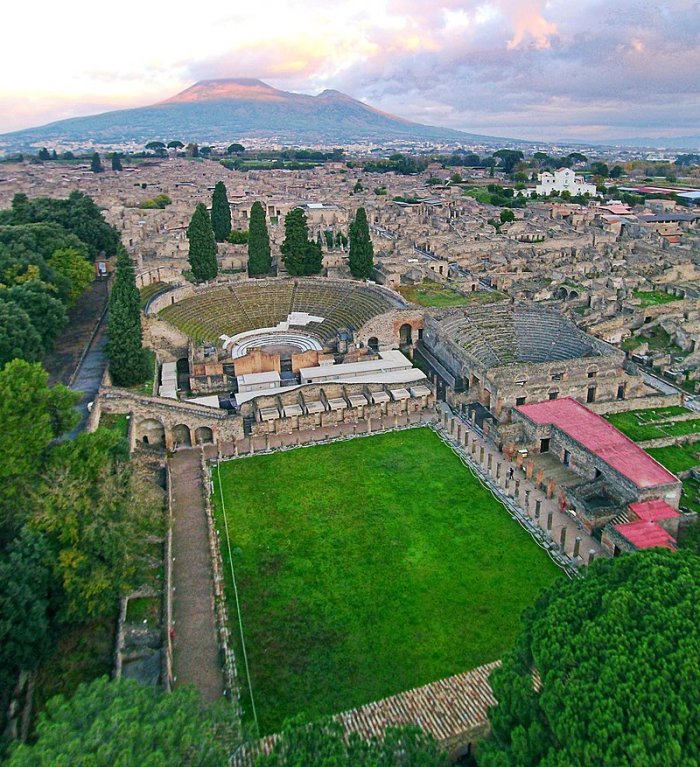Jan Bartek - AncientPages.com - A recent DNA study has yielded significant insights into life in ancient Pompeii. Researchers have analyzed ancient DNA collected from the well-known body casts, and their findings challenge the historical narratives established since the town's rediscovery in the 1700s. This new evidence offers a deeper understanding of Pompeii's past, reshaping our knowledge of this iconic archaeological site.
Left: DNA string. Credit: Public Domain - Pixabay - Right: Pompeii body casts. Credit: Archeological Park of Pompeii. Image compilation by Ancient Pages
In 79 CE, the Somma-Vesuvius volcanic system in southern Italy erupted, leading to the burial of the Roman town of Pompeii and its inhabitants under a thick layer of ash. This event, known as the "Pompeii eruption," remarkably preserved many bodies and artifacts.
Over several decades, modern archaeologists have meticulously studied the site to reconstruct daily life in ancient Pompeii. Among their discoveries are fascinating terracotta figurines and stunning mythological frescoes that once decorated Pompeian homes. Additionally, advancements in artificial intelligence have significantly aided scientists in recreating ancient ruins at Pompeii. These findings represent just a fraction of what has been uncovered, highlighting that there is still much more to learn about this historic city.
New Insight Into Families In Ancient Pompeii
"The scientific data we provide do not always align with common assumptions," says David Reich of Harvard University. "For instance, one notable example is the discovery that an adult wearing a golden bracelet and holding a child, traditionally interpreted as a mother and child, were an unrelated adult male and child. Similarly, a pair of individuals thought to be sisters, or mother and daughter, were found to include at least one genetic male. These findings challenge traditional gender and familial assumptions."
The research team, which includes Alissa Mittnik from Harvard University and David Caramelli from the Università di Firenze in Italy, embarked on a study to explore the diversity and origins of Pompeii's residents. By utilizing ancient DNA analysis and strontium isotopes for dating samples, they aimed to gain deeper insights into the population of Pompeii. The team extracted DNA from highly fragmented skeletal remains found within plaster casts, focusing on 14 out of 86 casts currently undergoing restoration.
Their objective was to gather as much information as possible about these 14 individuals through genetic evidence. This approach enabled them to accurately determine genetic relationships, sex, and ancestry. The findings challenged long-standing assumptions based solely on the physical appearance and positioning of the casts.
The genetic data revealed that Pompeii's inhabitants had diverse genomic backgrounds, primarily descending from recent immigrants originating in the eastern Mediterranean region. This discovery underscores the cosmopolitan nature of the Roman Empire at that time, according to researchers involved in this study.
Theaters of Pompeii seen from the above with a drone, with Mt. Vesuvius in the background. Credit: ElfQrin - CC BY-SA 4.0
"Our findings have significant implications for the interpretation of archaeological data and the understanding of ancient societies," Mittnik says.
"They highlight the importance of integrating genetic data with archaeological and historical information to avoid misinterpretations based on modern assumptions. This study also underscores the diverse and cosmopolitan nature of Pompeii's population, reflecting broader patterns of mobility and cultural exchange in the Roman Empire."
The findings highlight the need for a multidisciplinary approach including genetic analysis to fully understand the past of Pompeii and beyond, the researchers say.
"This study illustrates how unreliable narratives based on limited evidence can be, often reflecting the worldview of the researchers at the time," Caramelli says.
The study was published in the journal Current Biology
Written by Jan Bartek - AncientPages.com Staff Writer







